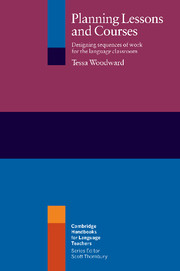Book contents
- Frontmatter
- Contents
- Thanks and Acknowledgements
- Map of the book
- Introduction
- 1 Who are the students?
- 2 How long is the lesson?
- 3 What can go into a lesson?
- 4 How do people learn and so how can we teach?
- 5 What can we teach with?
- 6 How can we vary the activities we do?
- 7 Getting down to the preparation
- 8 What are our freedoms and constraints?
- Bibliography
- Index
4 - How do people learn and so how can we teach?
Published online by Cambridge University Press: 05 May 2010
- Frontmatter
- Contents
- Thanks and Acknowledgements
- Map of the book
- Introduction
- 1 Who are the students?
- 2 How long is the lesson?
- 3 What can go into a lesson?
- 4 How do people learn and so how can we teach?
- 5 What can we teach with?
- 6 How can we vary the activities we do?
- 7 Getting down to the preparation
- 8 What are our freedoms and constraints?
- Bibliography
- Index
Summary
Introduction
In the first part of this chapter I'll look at four main ways that people can learn and be taught. These are:
Finding out for yourself
Things made plain
Periphery learning
Use and refinement
I'll explain what I mean by each of these four, detailing how they might be used outside language lessons. For each of the four ways of learning and being taught I'll then give language class examples, first of functional expressions and then for other content areas. In the second part of the chapter, I'll look at some common instructional sequences found in coursebooks and on teacher training courses. These are:
Test, teach, test
Pre-, in-, post- stages for receptive skills
PPP (Presentation, practice, production)
TBL (Task-based learning)
Ways of learning and teaching
Finding out for yourself
What it is and how it works
In this way of learning there is a natural setting for the exposure to the new and the learner does the noticing, pretty much on their own. I'll give an example from country life.
The quickest way to learn about the effect of an electric fence used to keep cattle in or out of an area is to blunder into one by mistake when it's switched on and to get a jolt from it. This teaches you that you are made up of conductive material, that electricity gives you an unpleasant shock, and that wires that tick should be avoided.
Information
- Type
- Chapter
- Information
- Planning Lessons and CoursesDesigning Sequences of Work for the Language Classroom, pp. 110 - 130Publisher: Cambridge University PressPrint publication year: 2001
